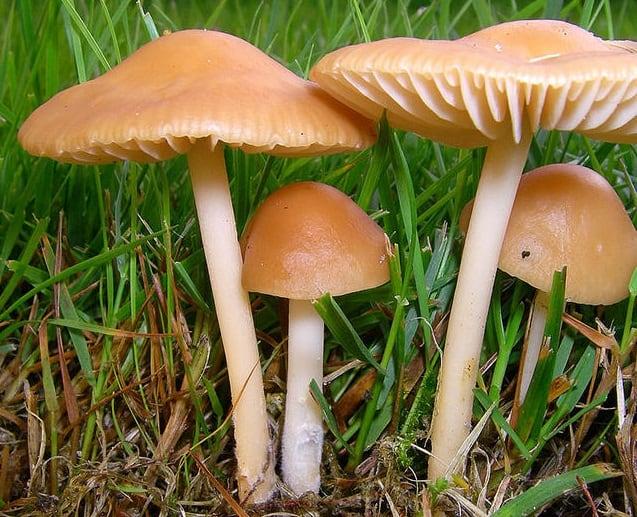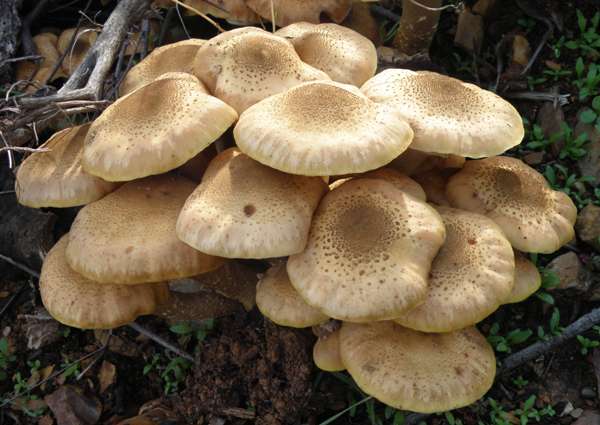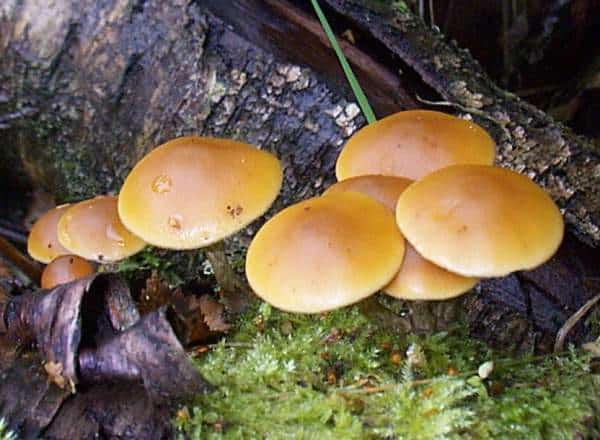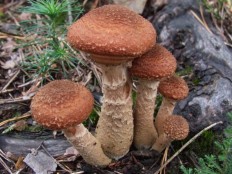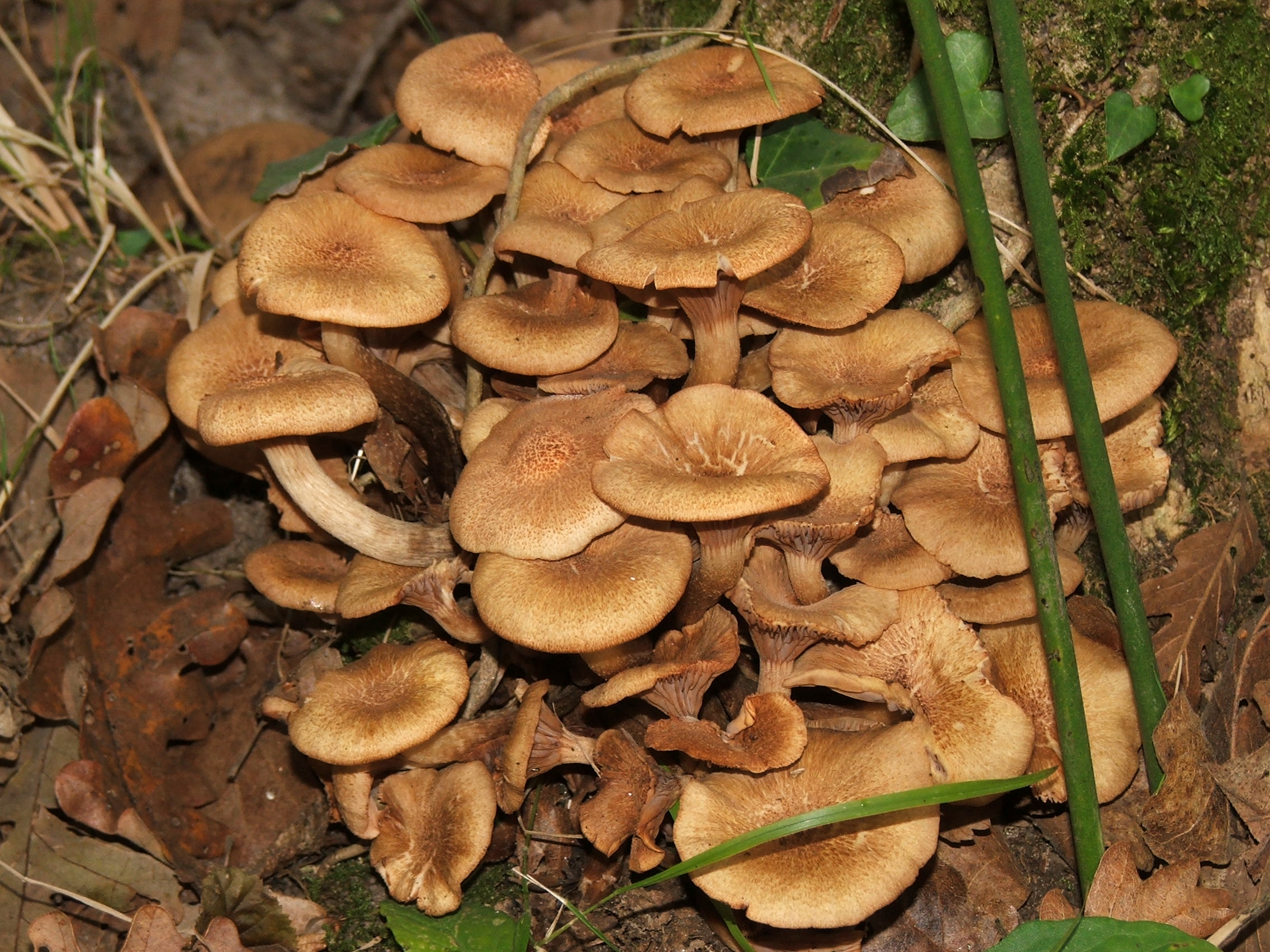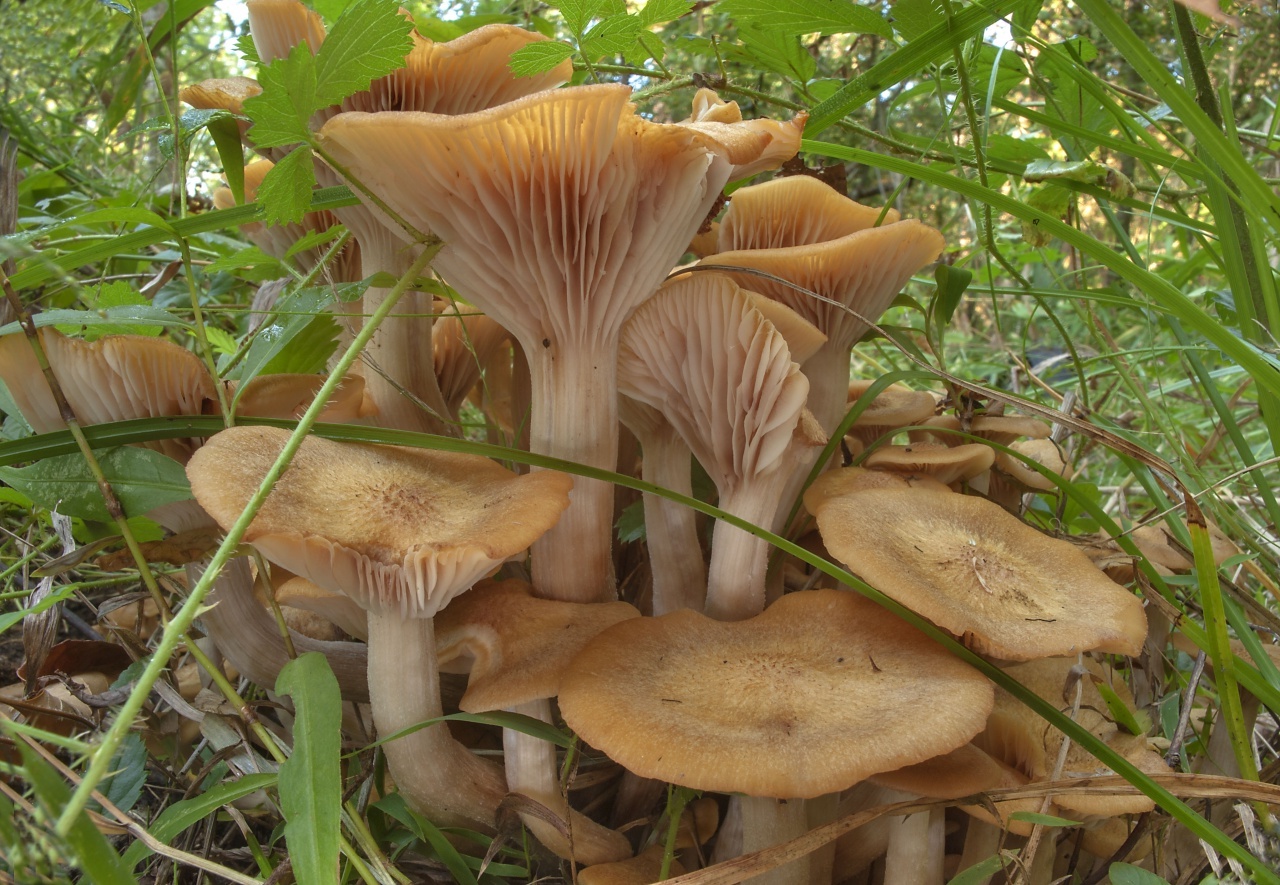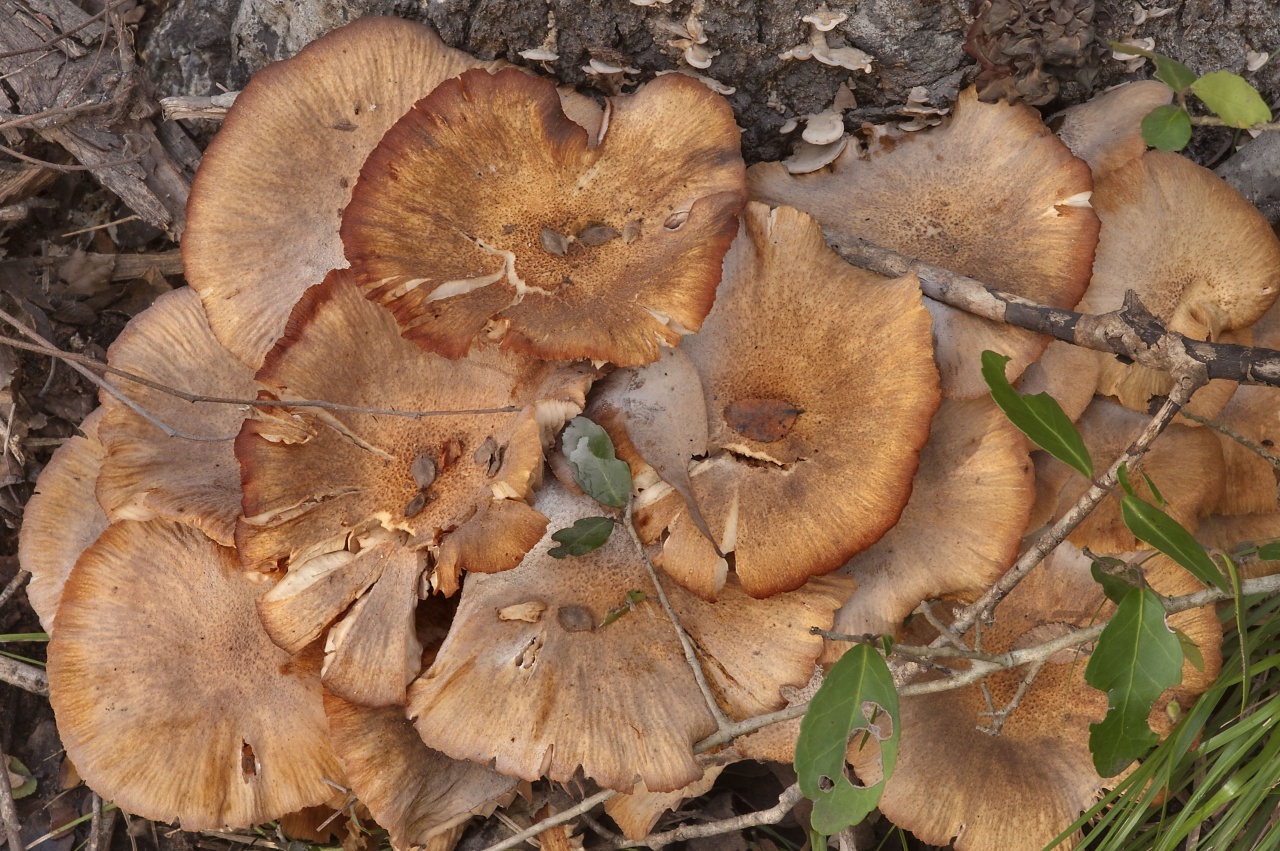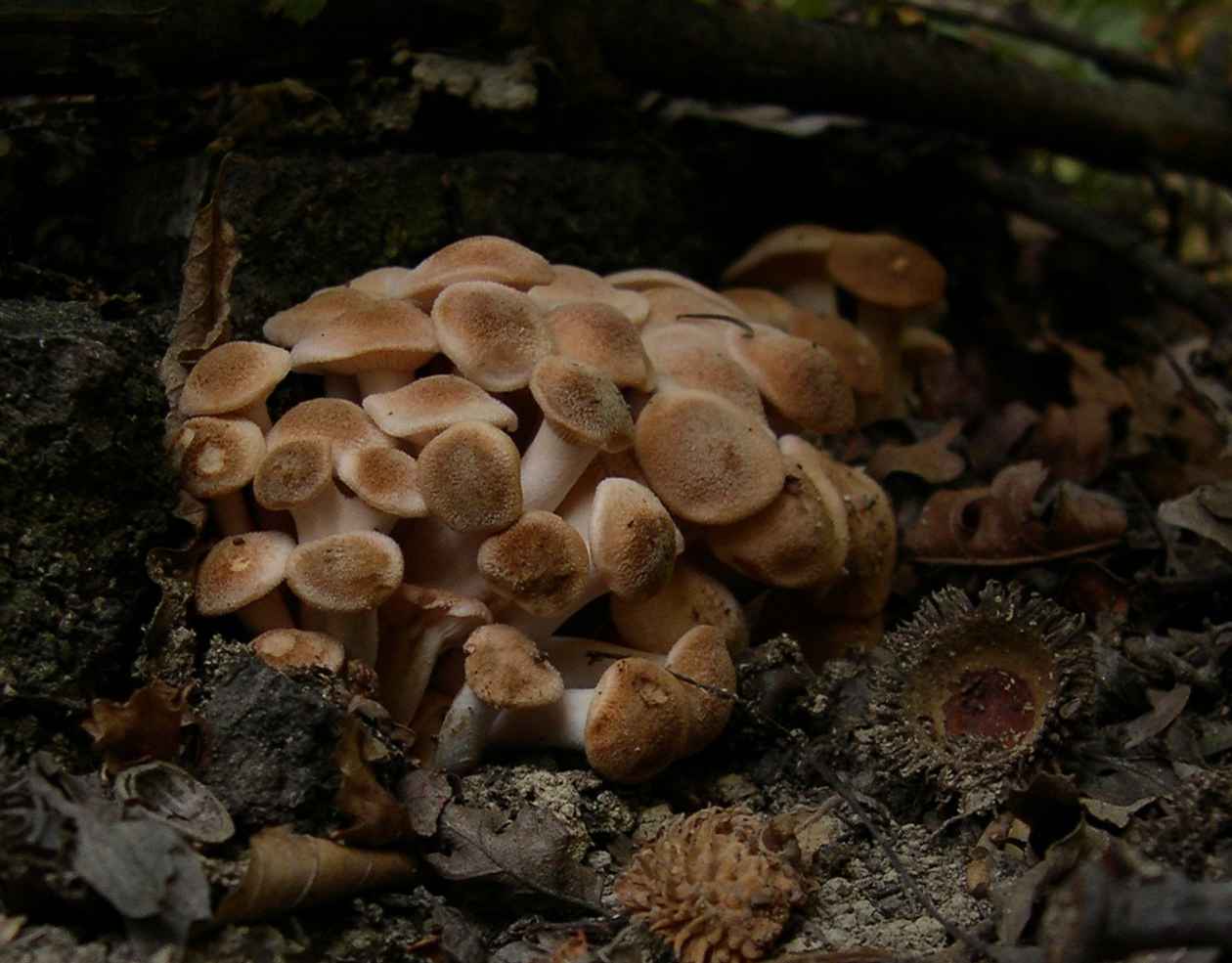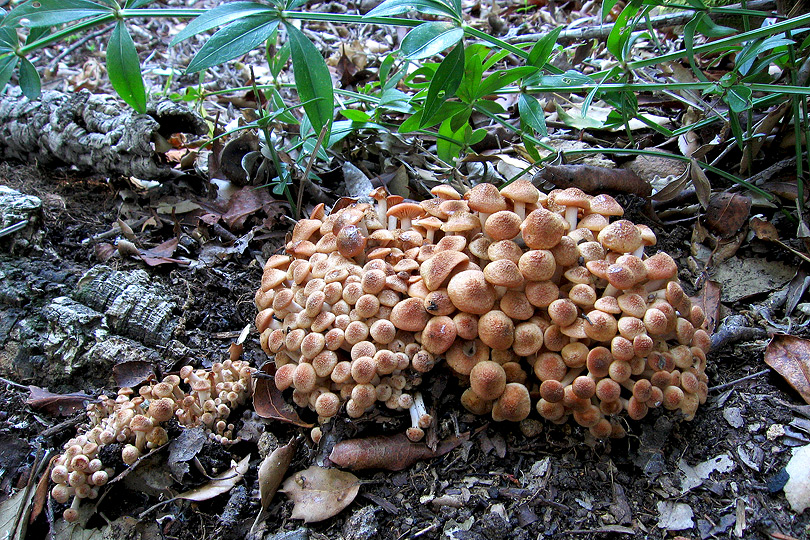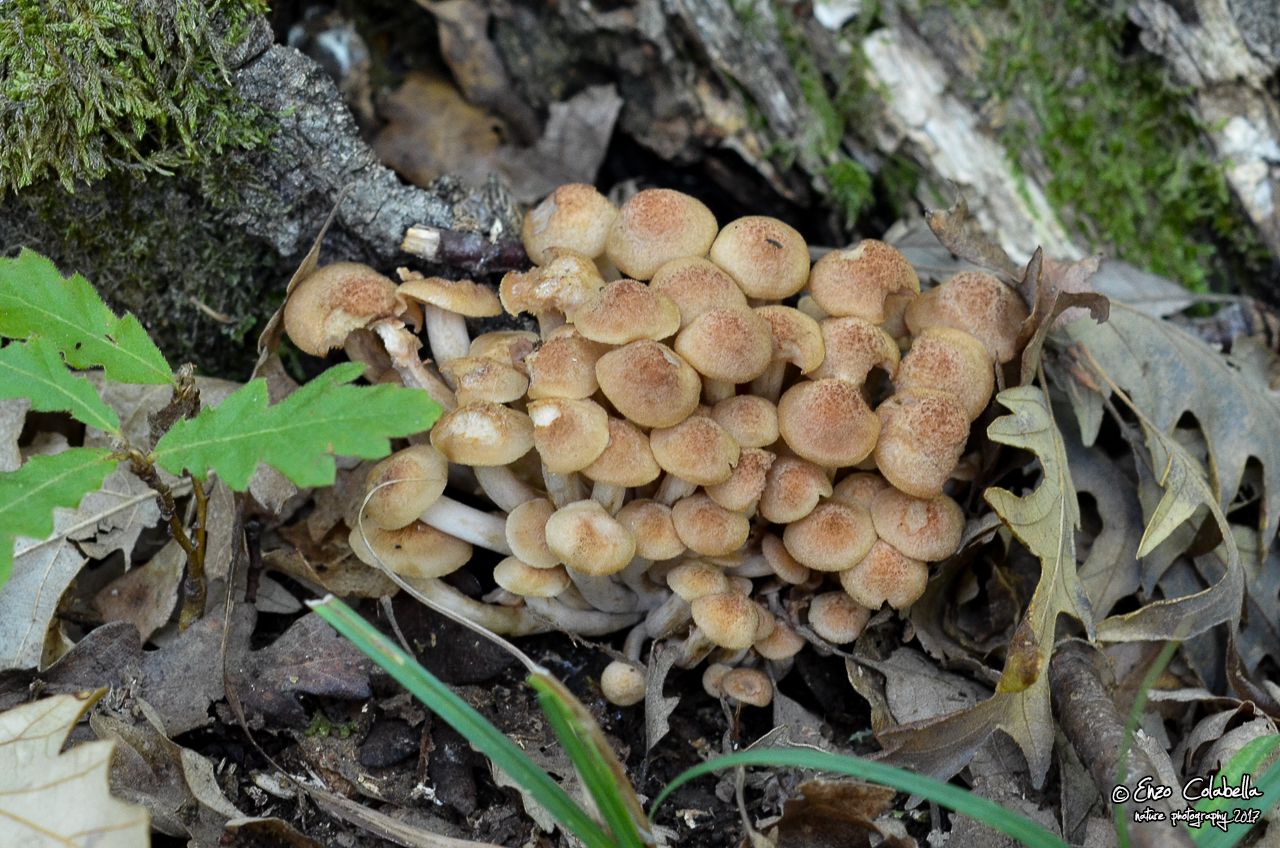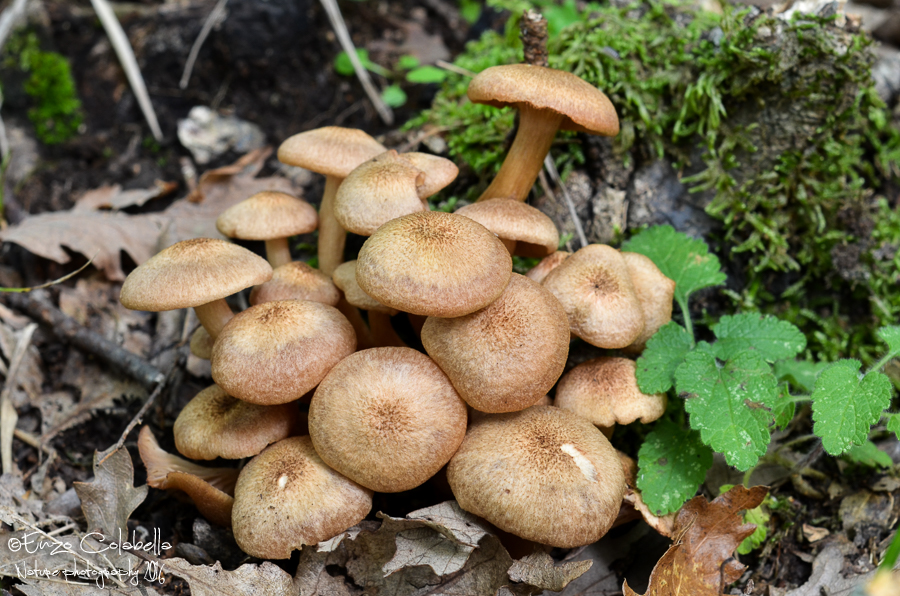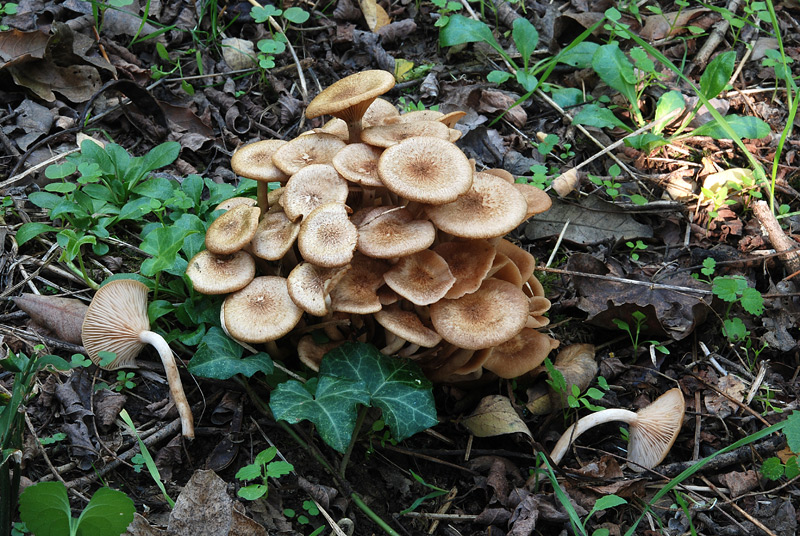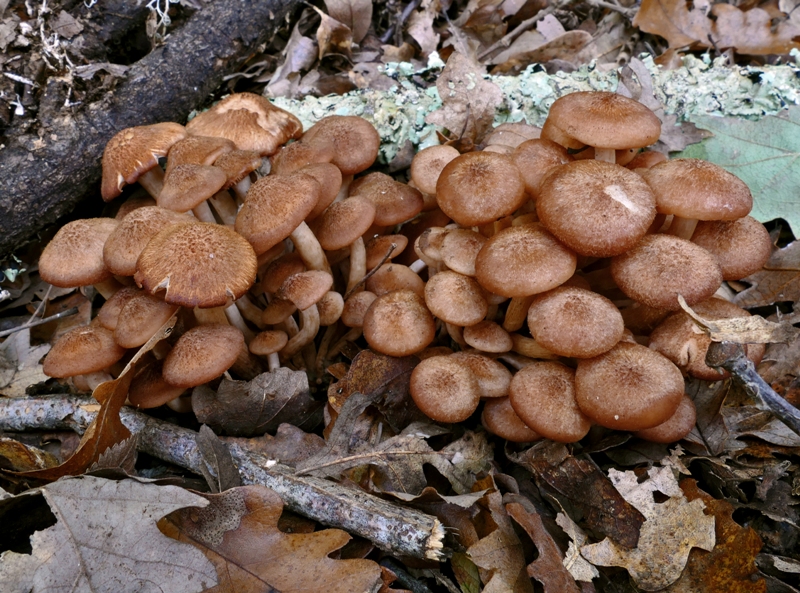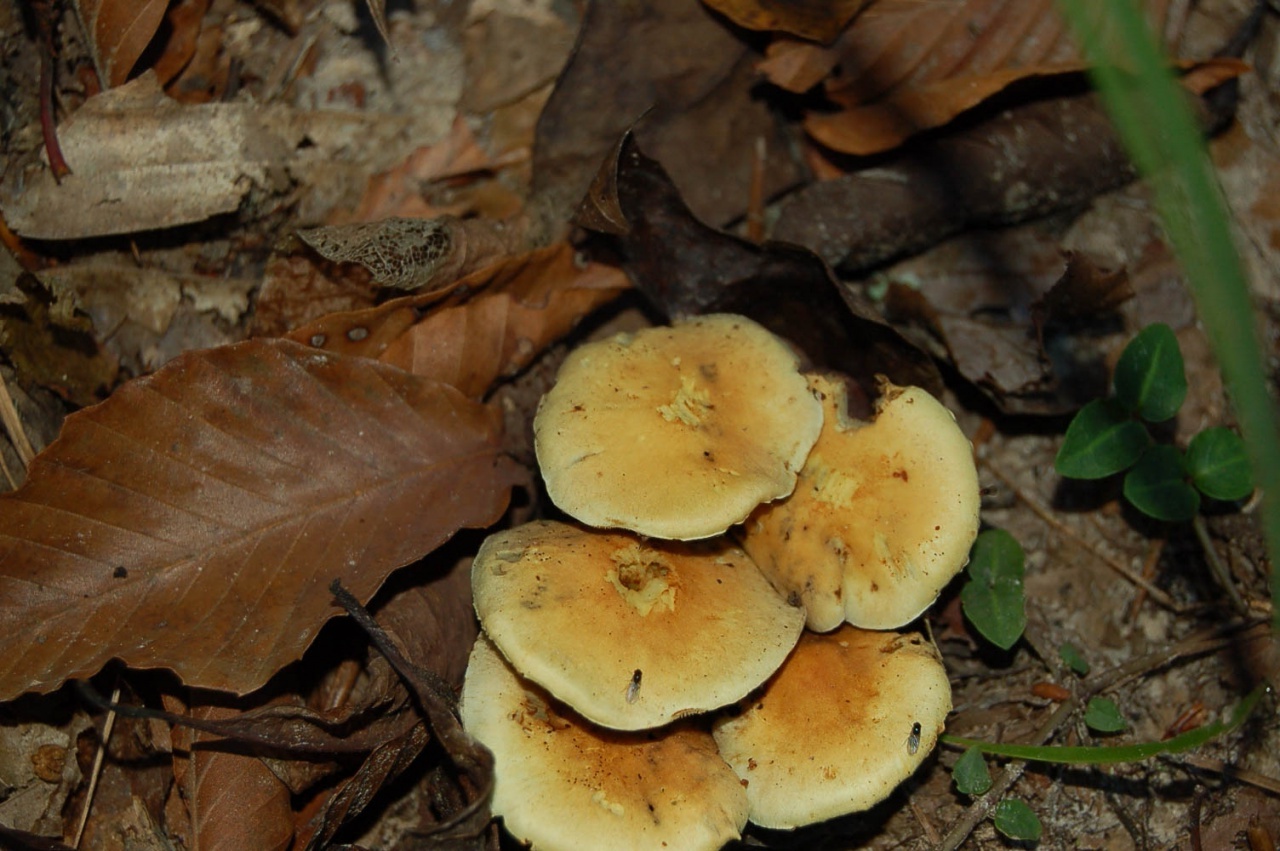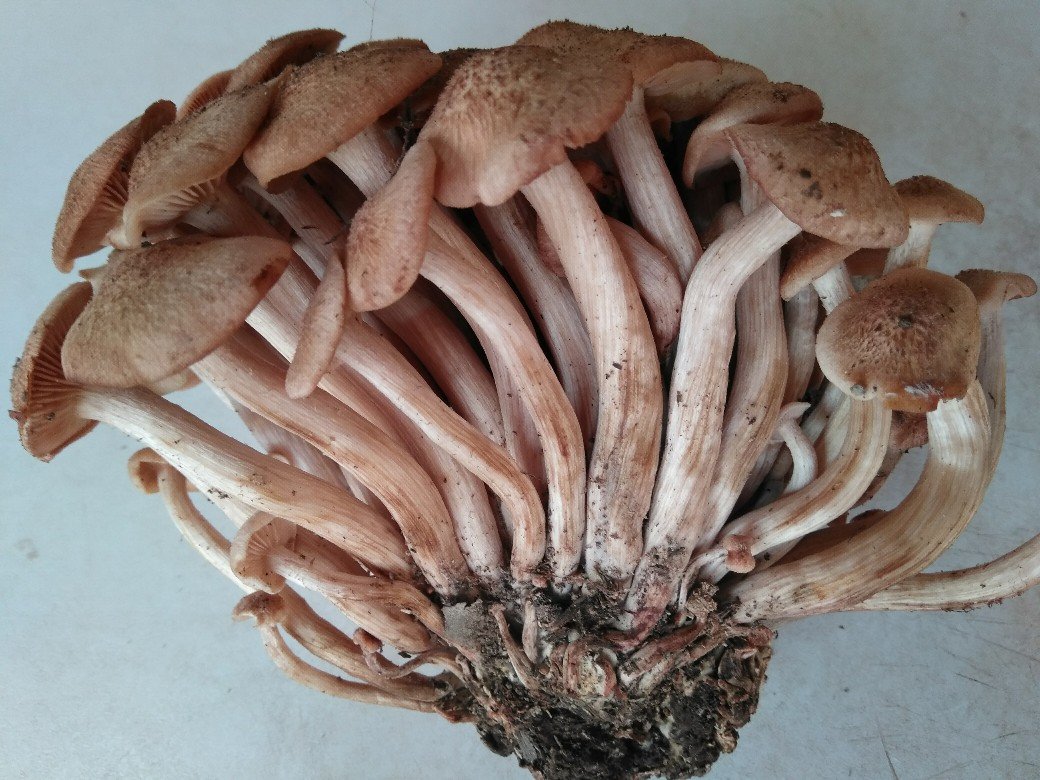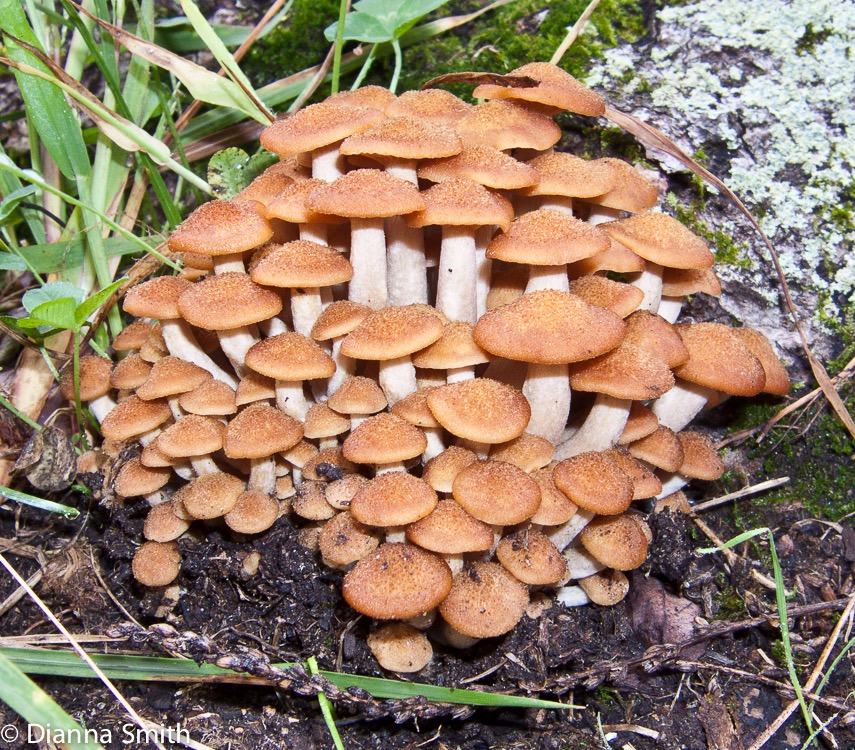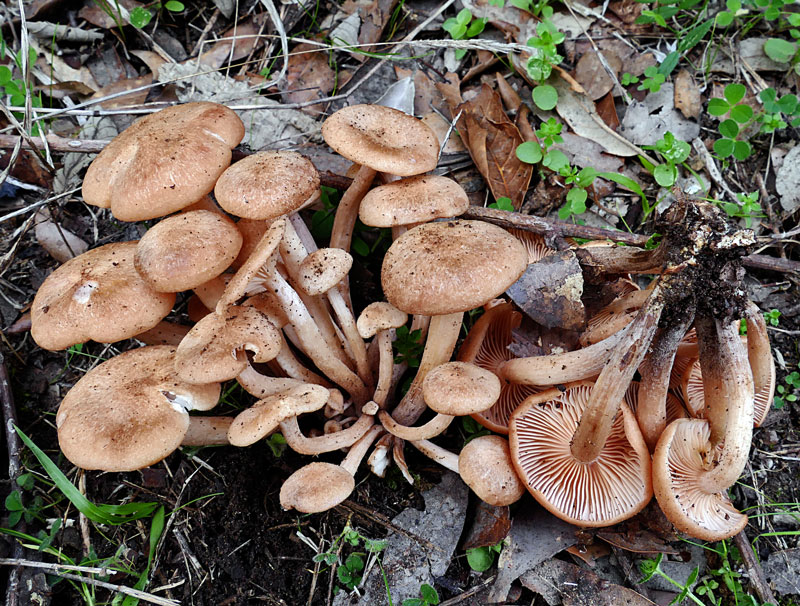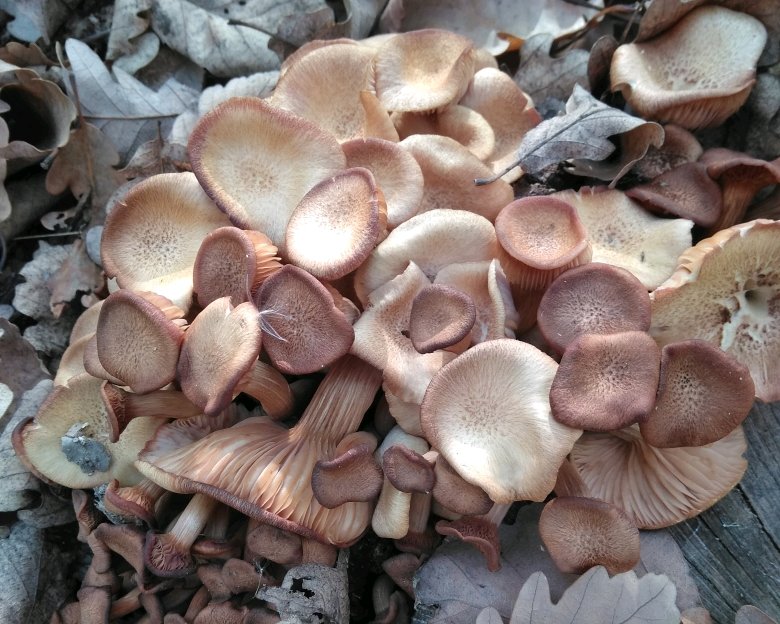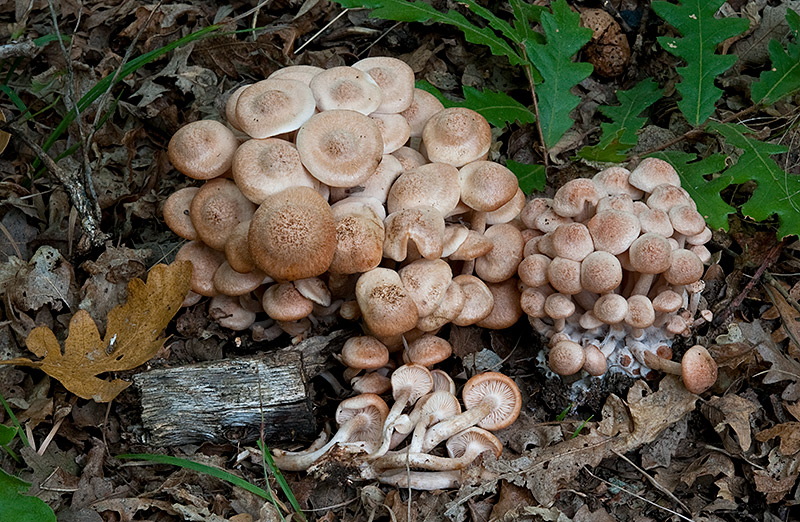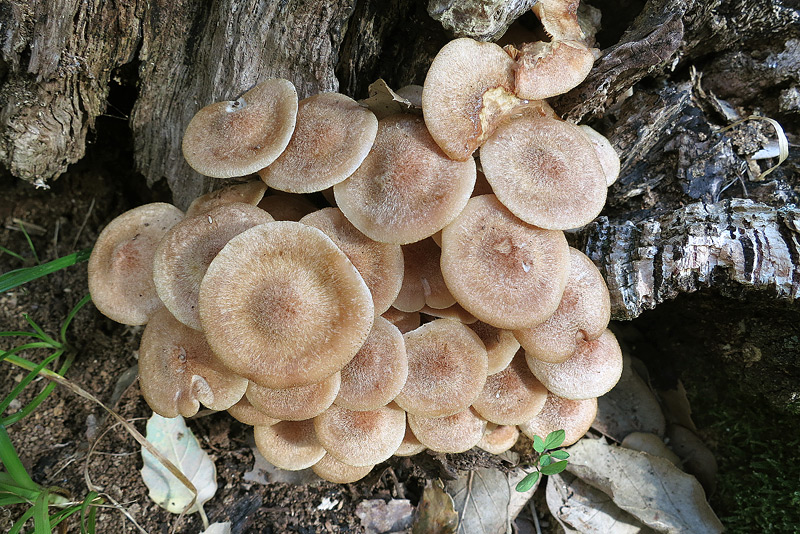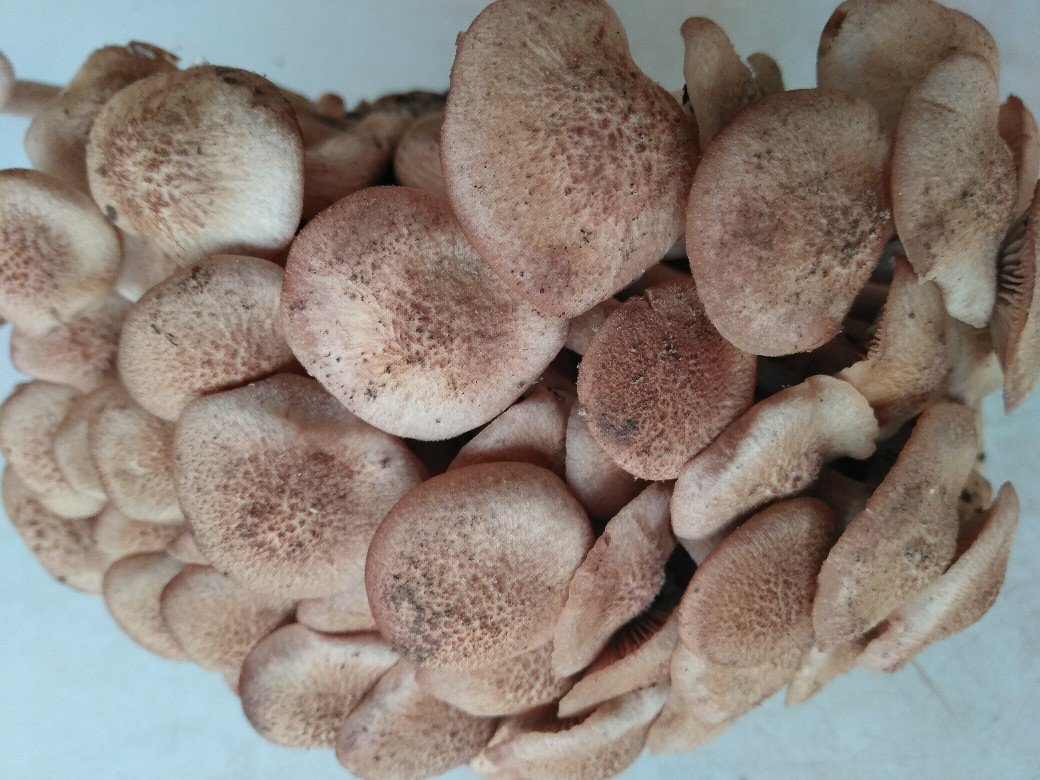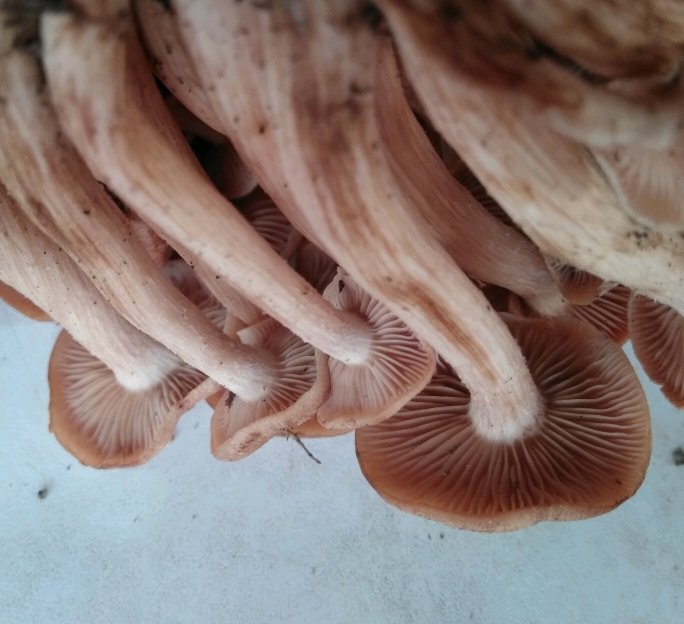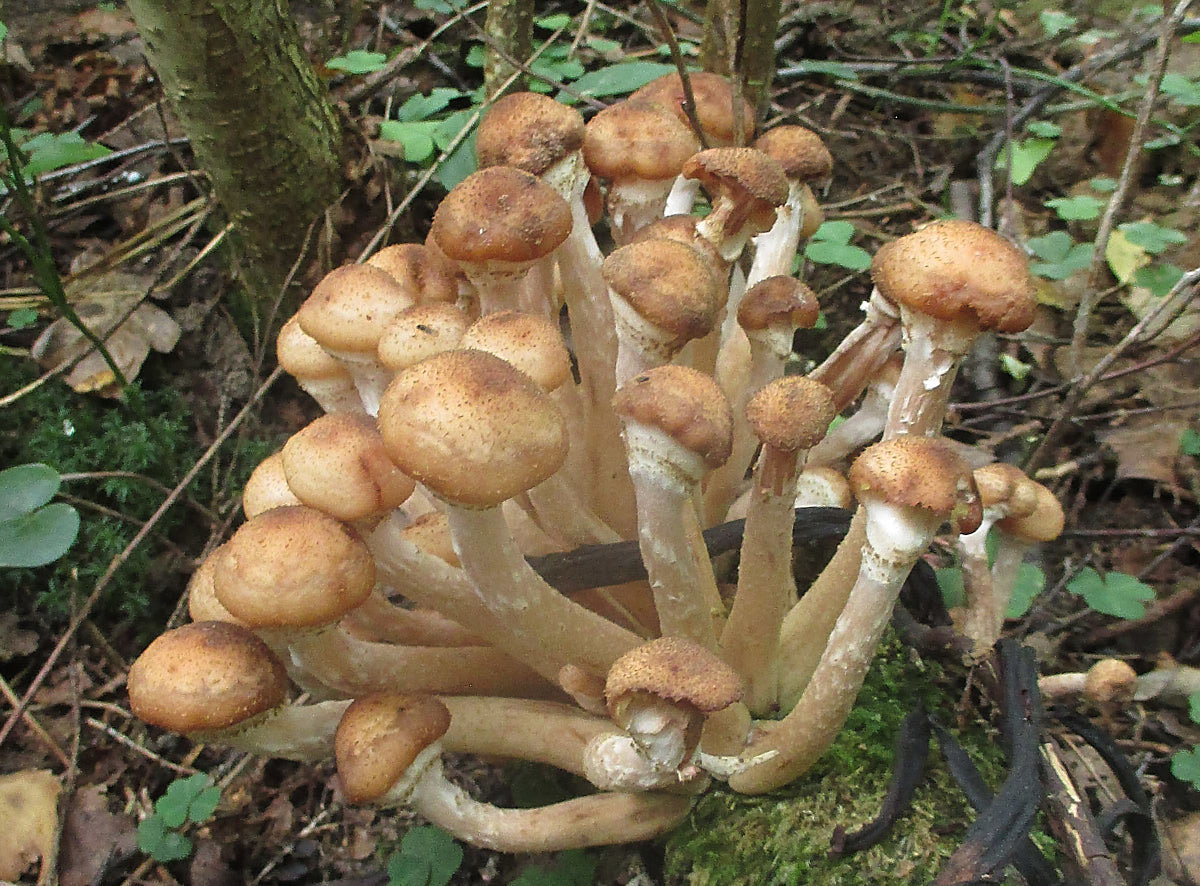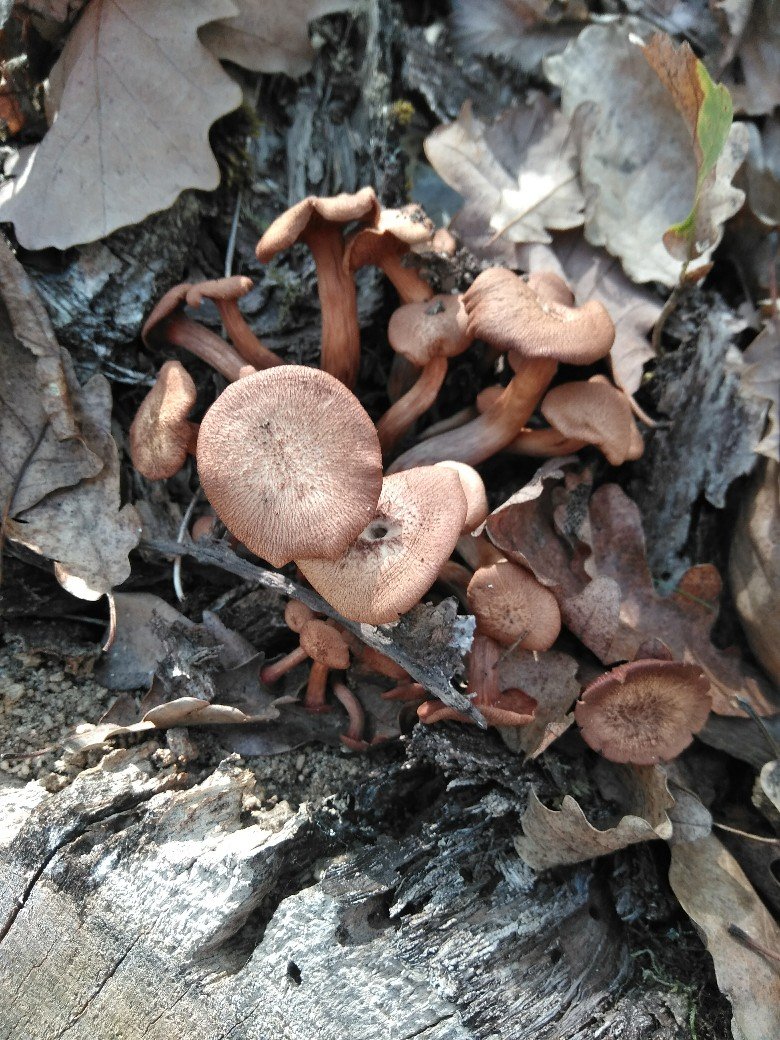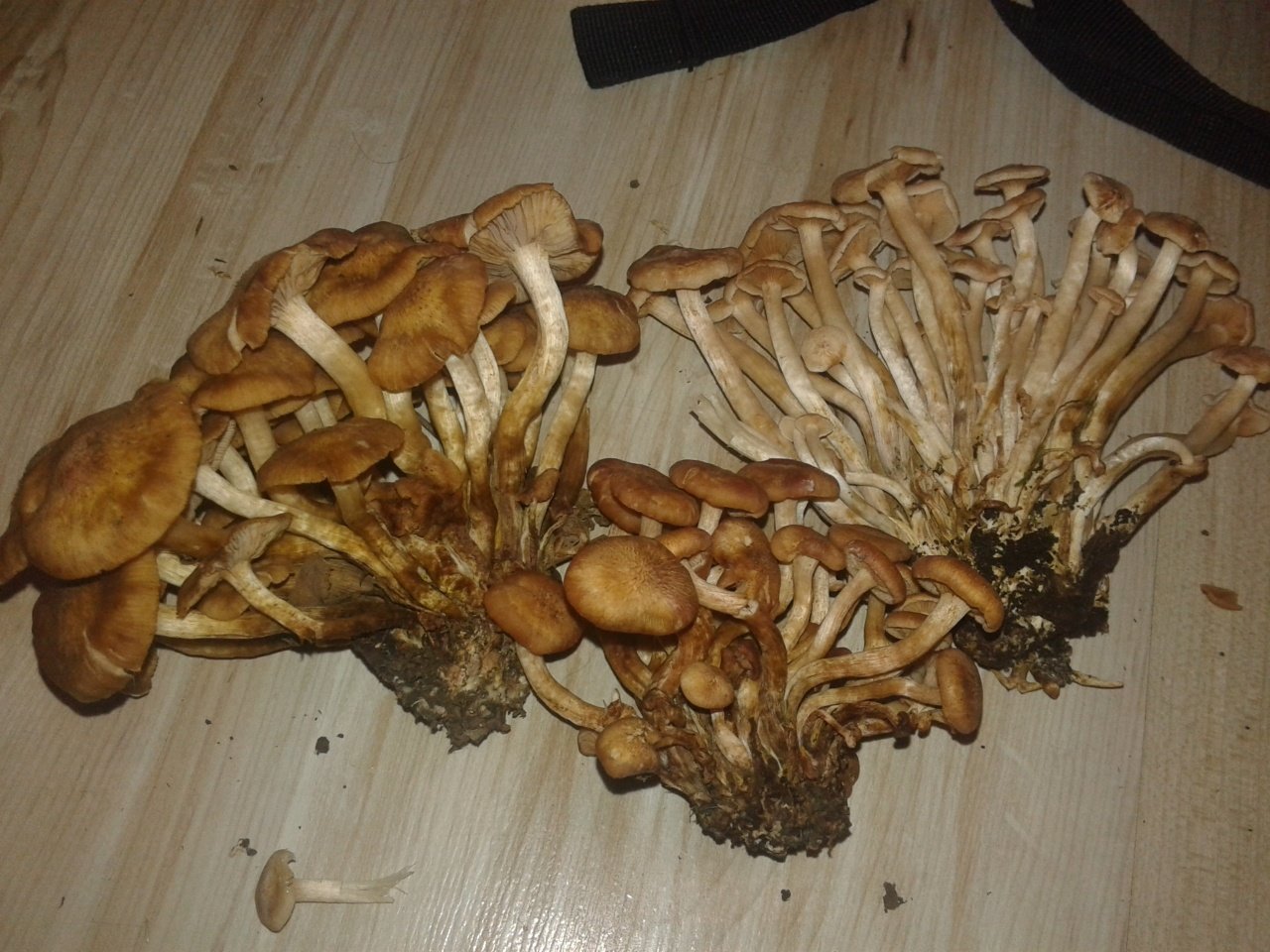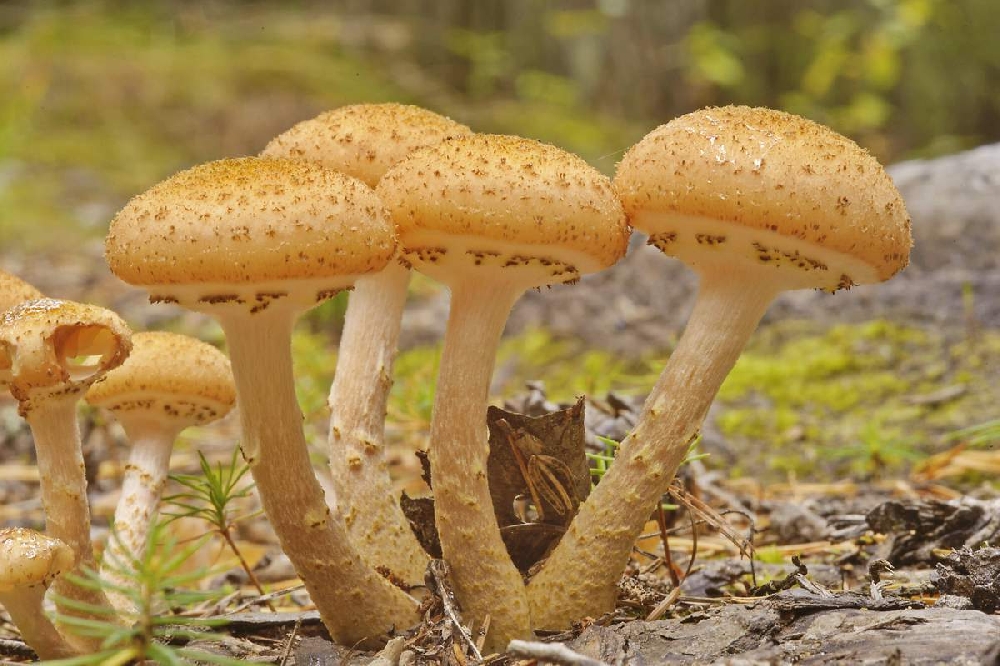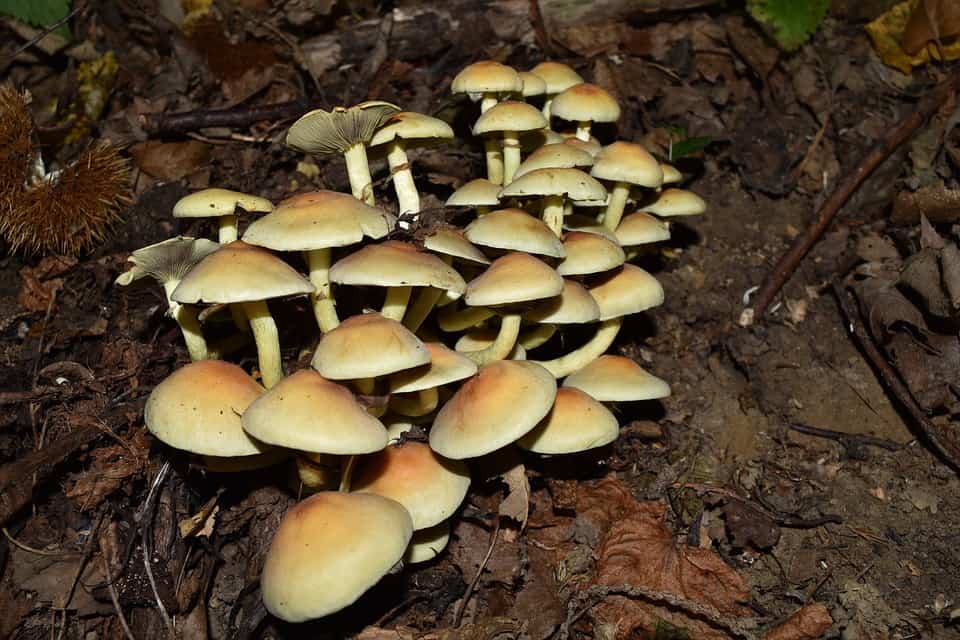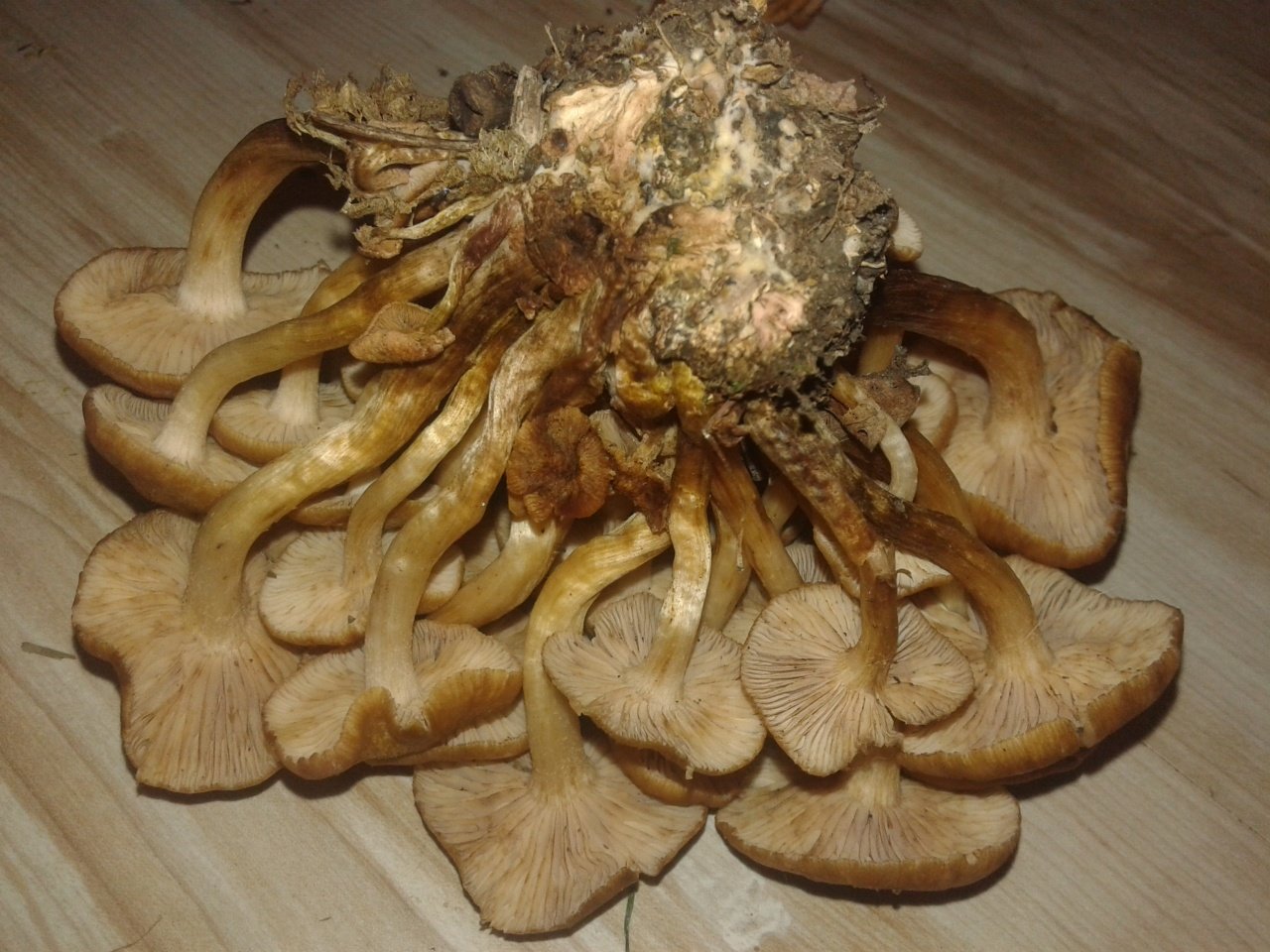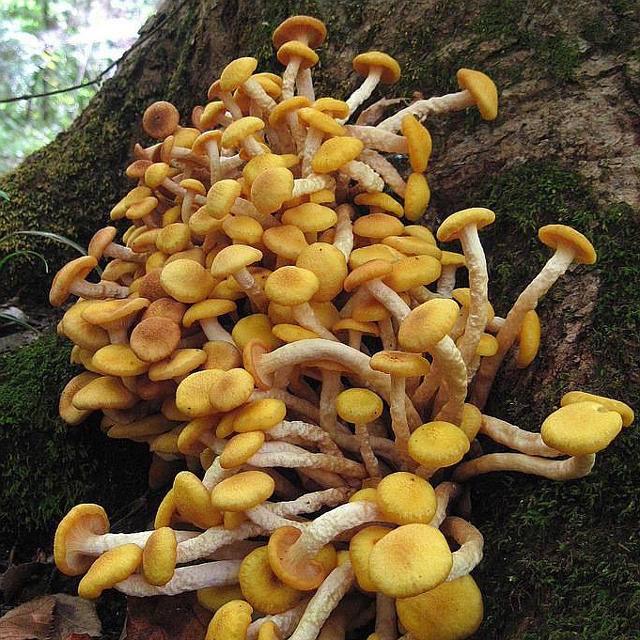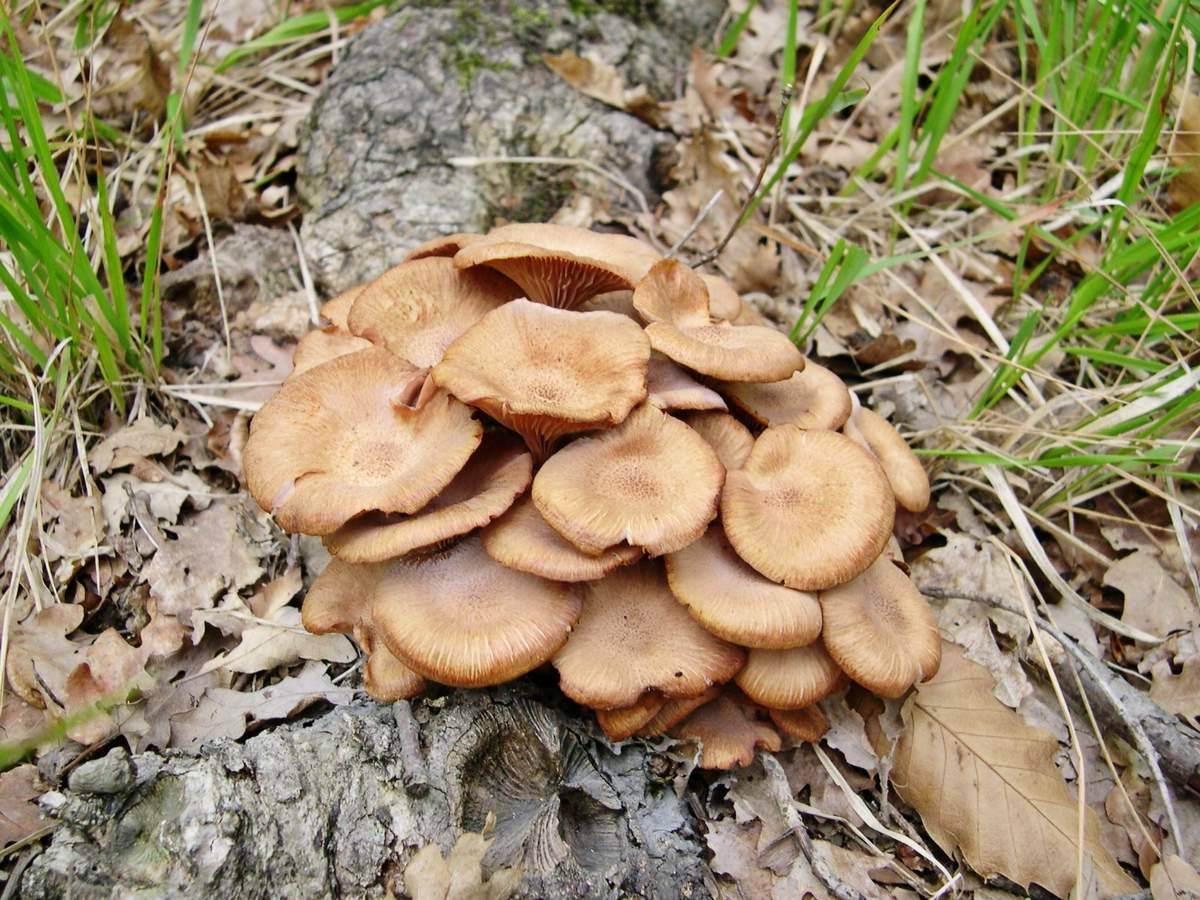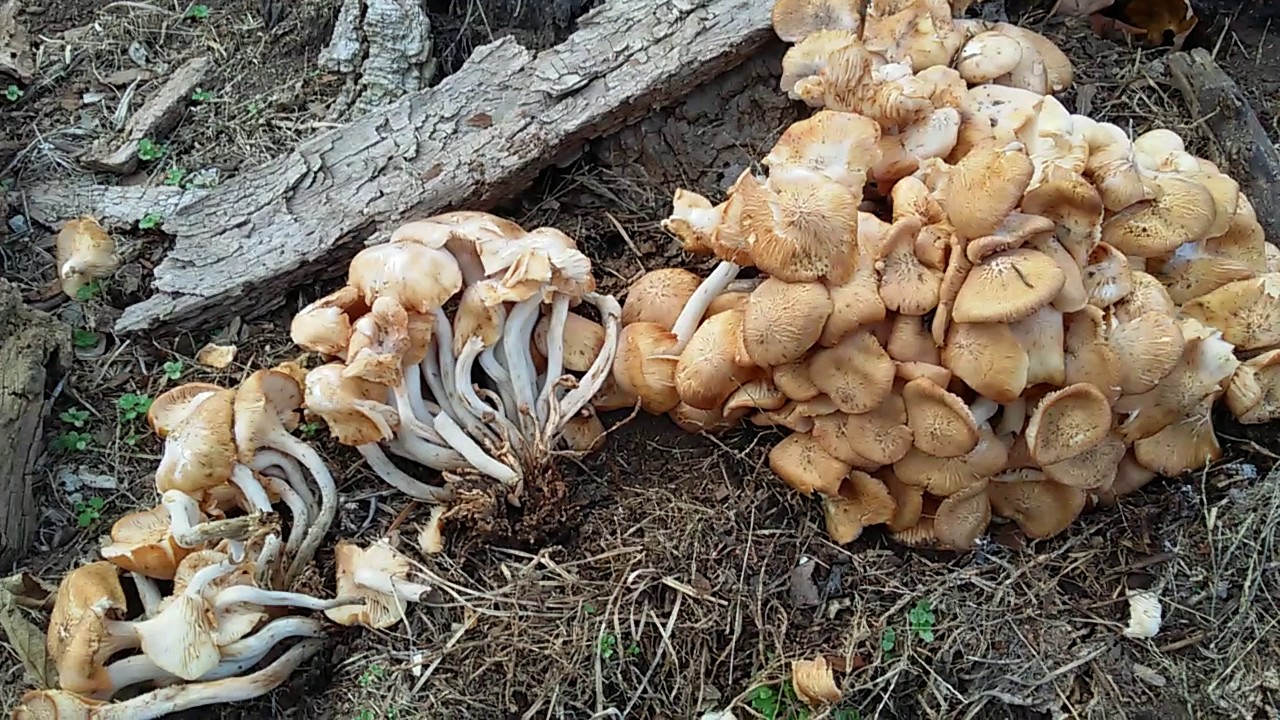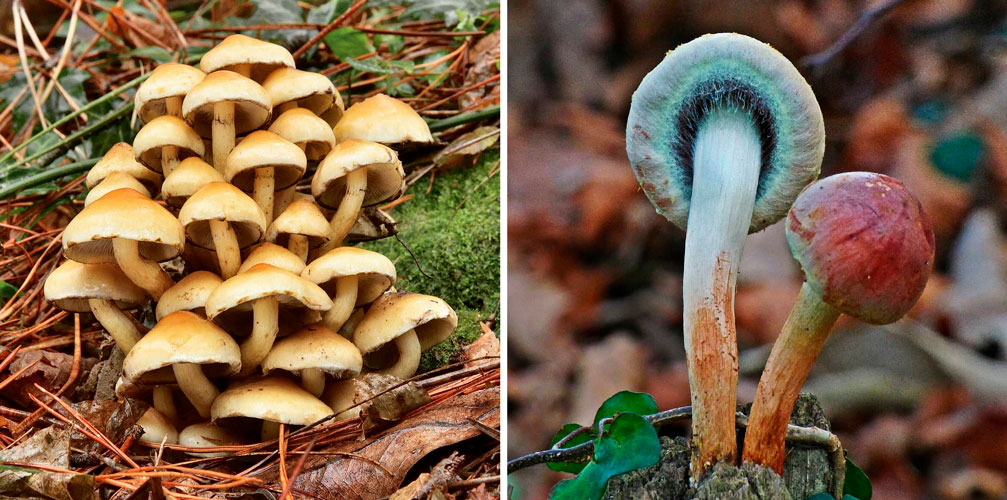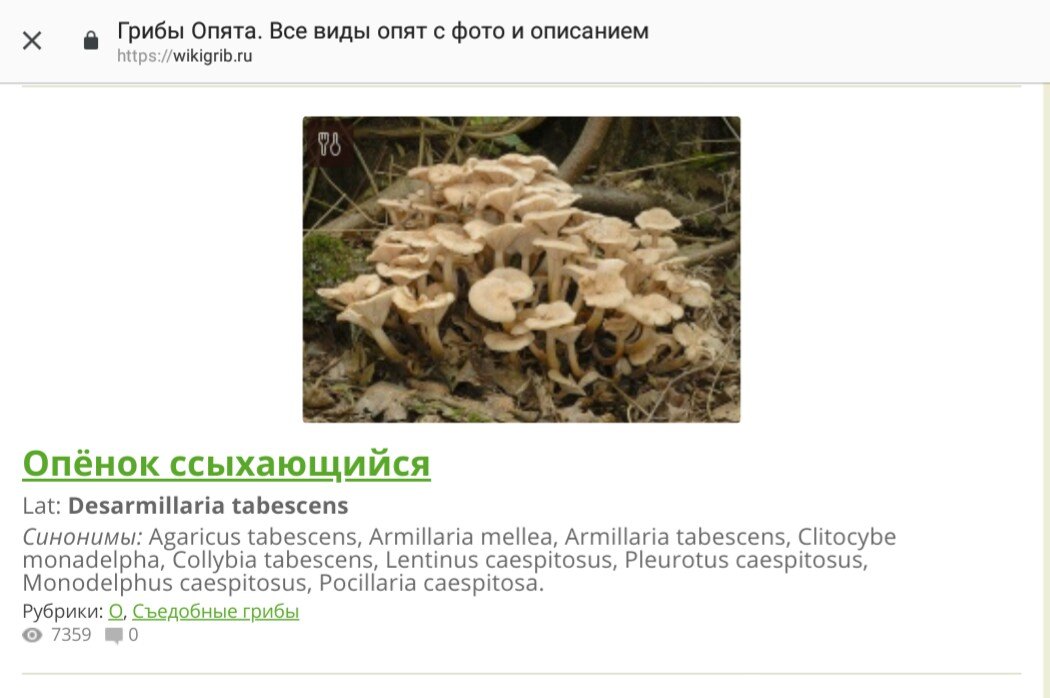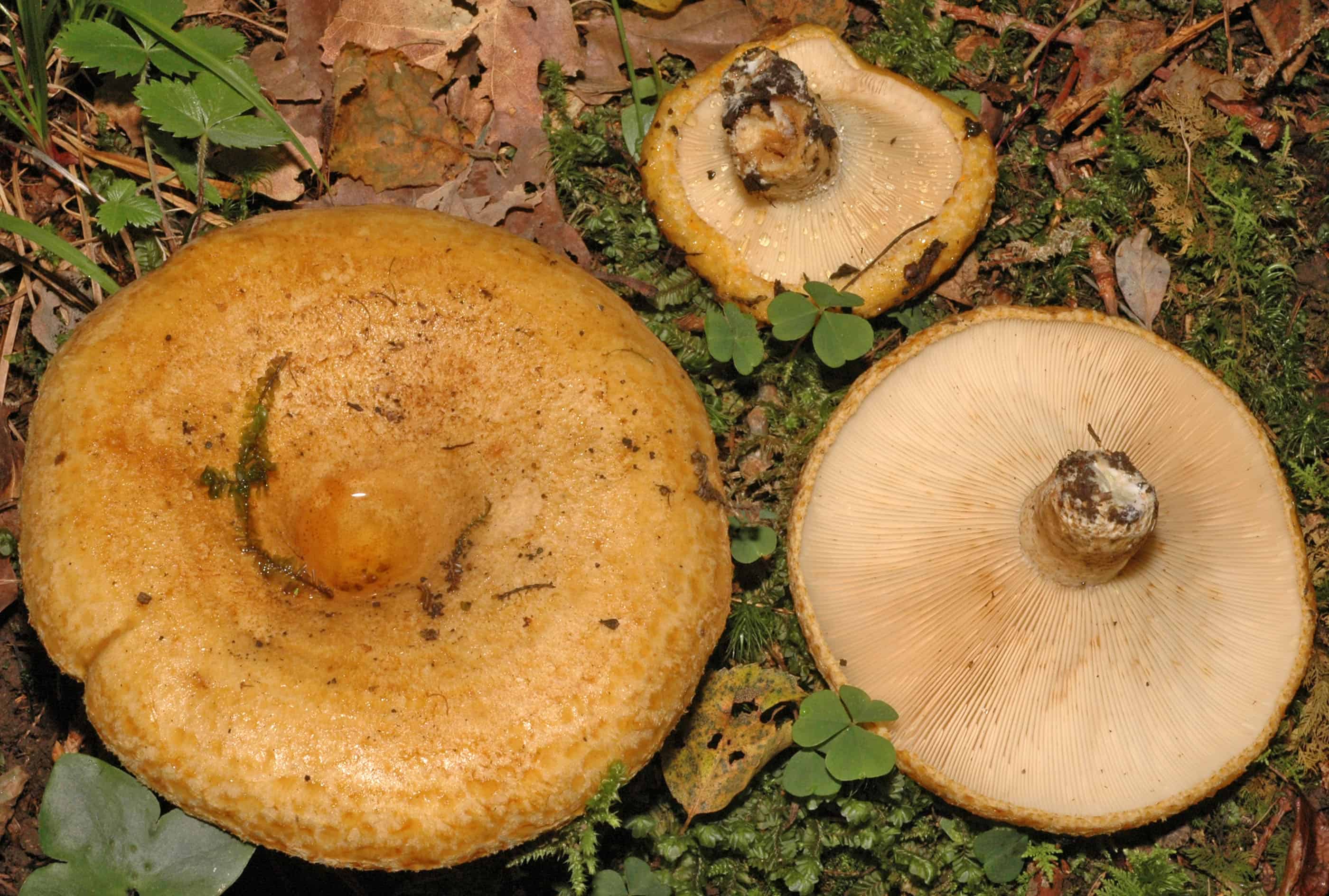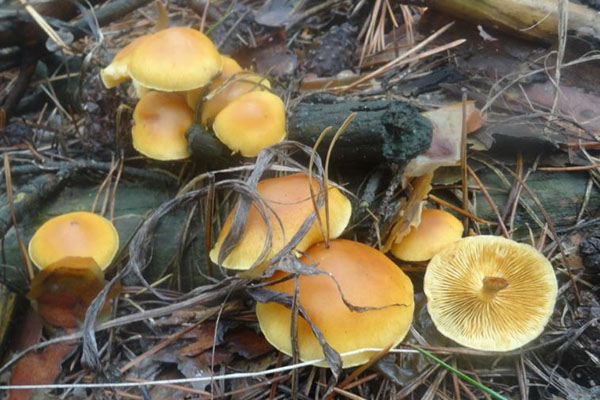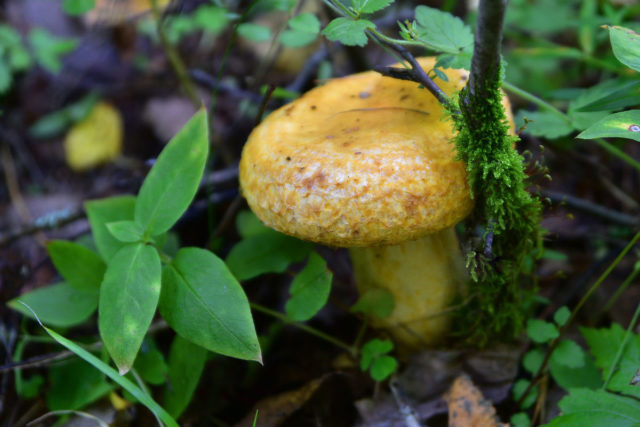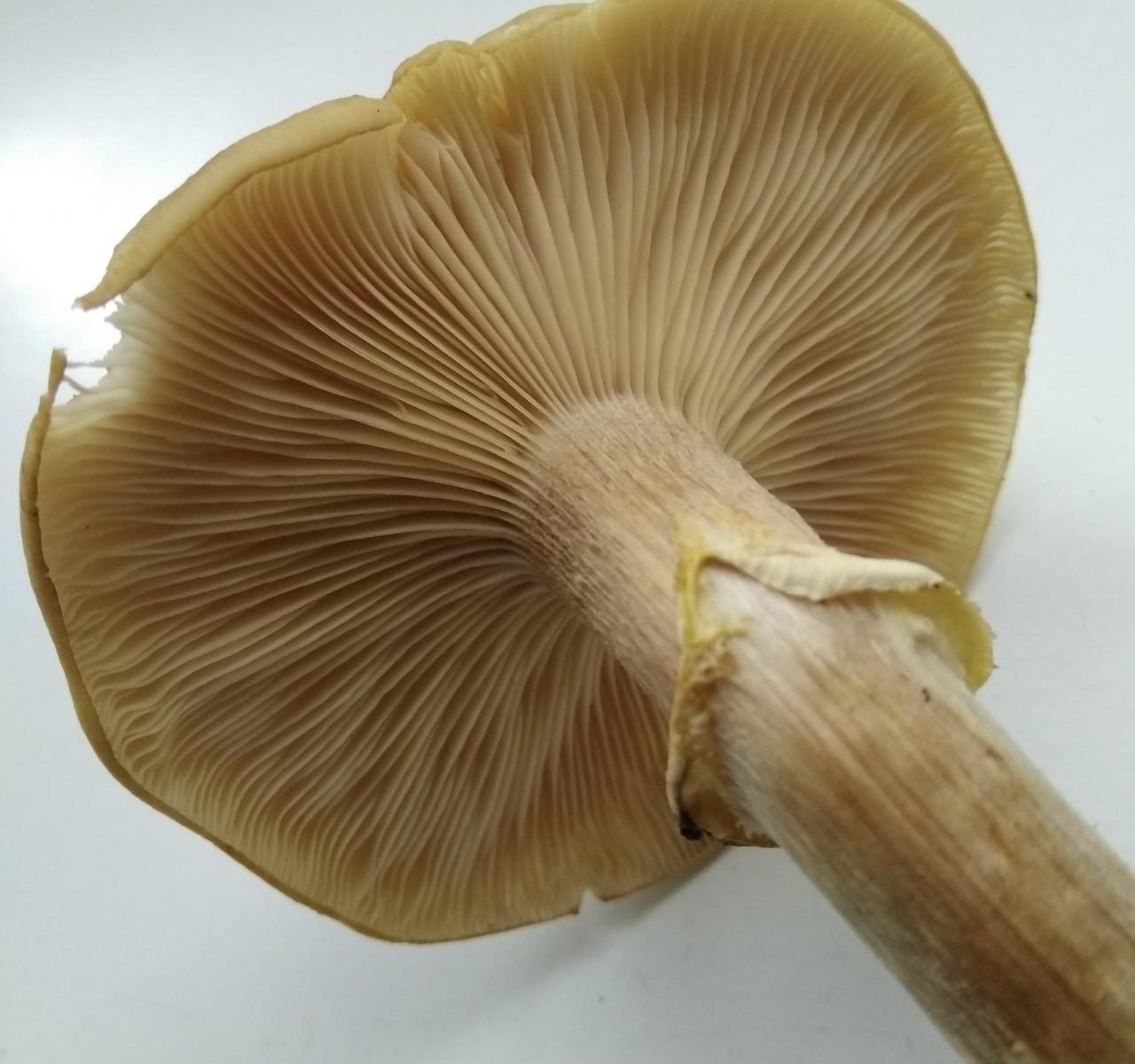Fatfoot honey fungus (Armillaria gallica)
Synonyms:
- Armillaria bulbosa
- Armillaria lutea
- Bulbous mushroom
Armillaria gallica is a species of fungi included in the genus Armillaria of the Physalacriaceae family.
Hat:
The diameter of the cap of the thick-legged honey fungus is 3-8 cm, the shape of young mushrooms is hemispherical, with a curled edge, with age it opens to almost open; the color is indefinite, on average rather light, grayish-yellow. Depending on the place of growth and the characteristics of the population, there are both almost white and rather dark specimens. The cap is covered with small dark scales; as they grow older, the scales migrate to the center, leaving the edges almost smooth. The flesh of the cap is white, dense, with a pleasant "mushroom" smell.
Plates:
Slightly descending, frequent, yellowish at first, almost white, acquiring an ocher color with age. In overripe mushrooms, characteristic brown spots are visible on the plates.
Spore powder:
White.
Leg:
The length of the leg of the thick-legged honey fungus is 4-8 cm, diameter is 0.5-2 cm, cylindrical, usually with a tuberous swelling at the bottom, lighter than the cap. In the upper part there are the remains of the ring. The ring is white, cobweb, delicate. The pulp of the leg is fibrous, tough.
Spreading:
Fatfoot honey agaric grows from August to October (sometimes it comes across in July) on rotting tree debris, as well as on the soil (especially on the spruce litter). Unlike the dominant species Armillaria mellea, this variety, as a rule, does not infect living trees, and it bears fruit not in layers, but constantly (though not so abundantly). It grows on the soil in large groups, but, as a rule, does not grow together in large bunches.
Similar species:
This variety differs from the "basic model" called Armillaria mellea, firstly, in the place of growth (mainly forest litter, including coniferous, less often stumps and dead roots, never living trees), and secondly, in the shape of the leg ( often, but not always the characteristic swelling in the lower part, for which this species was also called Armillaria bulbosa), and thirdly, a special "spider-web" private veil. You can also notice that the thick-legged honey agaric is, as a rule, smaller and lower than the Autumn honey agaric, but this sign can hardly be called reliable.
In general, the classification of species previously united under the name Armillaria mellea is an extremely confusing matter. (They would have combined further, but genetic studies have inexorably shown that fungi, which have very similar and, what is most unpleasant, very flexible morphological characters, are still completely different species.) A certain Wolf, an American researcher, called the genus Armillaria a curse and disgrace of modern mycology, with which it is difficult to disagree. Each professional mycologist, seriously dealing with mushrooms of this genus, has his own view of its species composition. And there are many professionals in this row - as you know, Armillaria is the most dangerous parasite of the forest, and they do not spare money for its research.
Edibility:
One of the most popular commercially harvested mushrooms.
Pickers are generally reluctant to distinguish between autumn mushroom varieties and are easy to understand.
How to cook a mushroom?
Drying mushrooms are good in any form. They should be cooked immediately after they get home. The maximum shelf life fresh is possible up to 24 hours. The simplest thing is to fry mushrooms with onions and serve with boiled potatoes, but there are other interesting recipes.
Primary processing

After the mushrooms have entered the house, they should be rinsed under running water and cleaned of forest debris. Remove all wormholes and rotten fruit, if any. Then immerse them in a bowl of water for an hour, where it will be easier for them to get rid of the debris that remains. Dry the mushrooms, now you can cook.
Pickling
For the preparation you will need:
- mushrooms - 1 kg;
- water - 350 ml;
- salt - 1 tbsp.l .;
- sugar - 1 tbsp. l .;
- vinegar - 2 tbsp. l .;
- sunflower oil - 50 ml;
- cloves - 2 pcs.;
- allspice - 3 pcs.;
- laurel leaves - 1pc.
To make mushrooms more tasty, before marinating, they should be boiled in water for 20 minutes, then the fruits are taken out, allowed to drain. Further preparation:
- Put a container of water on the fire, put salt, sugar, cloves, pepper and laurel. The marinade is boiled for 5 minutes.
- Pour in mushrooms, add vinegar after 15 minutes.
- After 10 minutes, the fruits are laid out in jars, a little vegetable oil is added on top, covered with a plastic lid and cooled at room temperature.
You can store such mushrooms in the basement or in the refrigerator on the bottom shelf. They are good not only as a separate dish, but also in salads, gravies and pies.
Salting
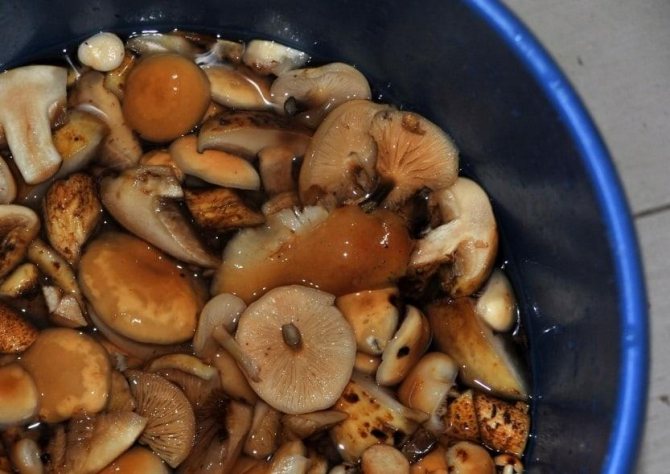
To crunch salty mushrooms, you will need:
- mushrooms - 2 kg;
- salt - 100 g;
- dill - 6 umbrellas;
- onions - 120 g;
- vegetable oil - 100 ml.
After preliminary preparation, put honey mushrooms in a saucepan and put on fire:
- Bring to a boil, after 1 min. drain the water, rinse the fruit bodies and, pouring fresh water, put it back on the fire.
- Now they are boiled for half an hour.
- Then drain the water, put the mushrooms in an enamel container, sprinkle them with salt, add 100 ml of water, cover with a plate and put the load.
- Honey mushrooms are salted for up to 20 days in a cool place, preferably in the refrigerator.
When serving, season the mushrooms with vegetable oil, add finely chopped onions and dill to them.
Drying
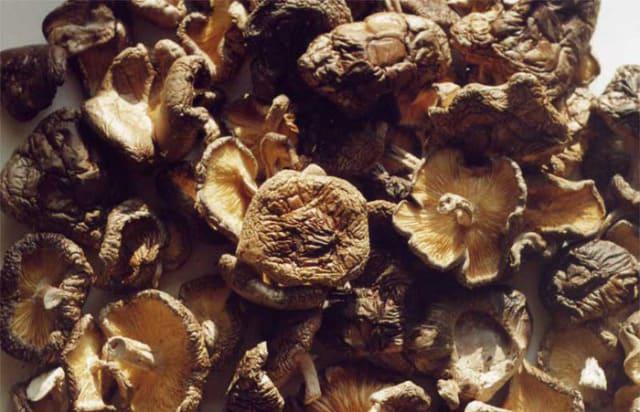
Mushrooms can be dried by stringing them in the sun, as well as in the oven, on the stove or in an electric dryer. It is dry mushrooms that retain the largest amount of nutrients. Pre-cooking will be slightly different:
- After the mushrooms have got home, it is enough to clean them of debris, separate them from each other, and cut the large ones into pieces, so they dry faster.
- To dry in the sun, string them on a string and hang in a sunny warm place.
- When using the oven, you will need to warm up the device to 70 degrees, spread the mushrooms on a baking sheet and place inside. They will dry for more than 5 hours, and therefore you should constantly monitor the process, turn the fruits in time.
- The mushrooms will be ready in the electric dryer in 3.5 hours, the temperature should be set at 50 degrees. After this time, the fruits are not taken out, but left for another 3 hours, then you need to turn on the device at 60 degrees and dry it.
Well-dried mushrooms should be springy, not break, but completely dry. If they began to crumble, then drying takes too long, the mushrooms are overexposed.
Calorie honey agaric
Nutritional value table for honey agarics, per 100 grams of product (BZHU):
| Product | Proteins, gr. | Fat, gr. | Carbohydrates, gr. |
| fresh mushrooms | 2,2 | 1,2 | 2,8 |
| fried | 1,9 | 3,5 | 3,1 |
| pickled | 1,8 | 1,0 | 0,4 |
When assembling fresh mushrooms, the most important thing is not to confuse them with similar false mushrooms, which can be deadly to our body.
Be also attentive to honey agaric preparation technology.
It is important to remember that when eating these mushrooms undercooked or salted in a cold way without sufficient exposure, there have been cases of poisoning
Based on the book by M. Vishnevsky “Medicinal mushrooms. Great Encyclopedia ".
Drying honey fungus (Armillaria tabescens) is a mushroom from the Physalacriaceae family, belongs to the genus Honey mushrooms. For the first time, a description of this type of mushroom was given in 1772 by a botanist from Italy, whose name was Giovanni Scopoli. Another scientist, L. Emel, managed in 1921 to transfer this species of mushrooms to the genus Armillaria. External description The fruiting body of the shrinking honeydew consists of a cap and a leg. The diameter of the cap varies between 3-10 cm. In young fruiting bodies, they have a convex shape, and in mature bodies they become widely convex and outstretched. A distinctive feature of the cap of a mature mushroom of shrinking honeydew is a noticeable convex tubercle located in the center.As for the cap itself, upon tactile contact with it, it is felt that its surface is dry, it has scales that are darker in color, and the color of the cap itself is presented in a reddish-brown color. The mushroom pulp is characterized by a brown or whitish color, an astringent, tart taste and a well-distinguishable aroma. The hymenophore is represented by plates that either grow to the pedicle or weakly descend along it. The plates are pinkish or white. The length of the leg of the described species is from 7 to 20 cm, and its thickness is from 0.5 to 1.5 cm. Downward it narrows, has a brownish or yellowish color at the bottom, and white at the top. The structure at the leg is fibrous. The mushroom leg has no ring. The spore powder of the plant is characterized by a creamy color and consists of particles with a size of 6.5-8 * 4.5-5.5 microns. The spores are ellipsoidal and have a smooth surface. Not amyloid. Season and Habitat Drying honey fungus (Armillaria tabescens) grows in groups, mainly on tree trunks and branches. You can also meet them on rotten, rotten stumps. Abundant fruiting of these mushrooms begins in June and continues until mid-December. Edible A mushroom called shrinking honey fungus (Armillaria tabescens) tastes very pleasant, suitable for eating in various forms.
Calocephalus is a silver coral. Home care
You will not always see this plant in the directory of indoor flowers. This is not surprising, since it is considered a garden one. But even among the reference books of garden plants, there are only a few copies where you can find at least some information about Calocephalus.
And to see him in nature is generally a great rarity and luck.
But lately, this culture appears quite often in flower shops. It is even painted in all the colors of the rainbow - for greater decorativeness.
Although, you must admit, the color of Kalocephalus itself is decorative - such a silvery openwork "rhapsody".
A bit of history
The flower came to the territory of the CIS quite recently - about 30 years ago. Despite the fact that it was discovered back in 1817 by Scottish botanist Robert Brown.
The full Latin name of the plant is Calocephalus brownii (Calocephalus Brown - in honor of the discoverer), the synonym is Leucophyta brownii, the Astrovye family. By the way, Calocephalus is translated from Greek as "beautiful head". But there are also other names: "silver coral" and "gray head".
Calocephalus (Leucophyta) is an endemic genus of southern Australia. Distributed mainly in the coastal zone.
The patient is more likely dead than alive
At first glance, it looks more like a dried flower than a living plant. But it is very lively, and its small, about 1 cm in diameter, pale yellowish-green flowers, which you will see in the middle of summer, can serve as proof of this.
Calocephalus is a compact juvenile (2-3 years old) shrub that, in good conditions, reaches about 1 m in diameter and the same height.
Stems and leaves are covered with silvery-white pubescence, which serves as a protection for the plant from intense light, and also contributes to less evaporation of moisture. The leaves are very small - up to 4 mm in length.
Most often, the plant is planted on alpine hills and rocky gardens. But there is one peculiarity - he is afraid of severe frosts. In winter, it must be brought into the room, since at temperatures below -5 ºС it can die.
Conditions of detention
It is necessary to keep it in a cool place in winter, for example, on a glassed-in loggia. And in the warm season, since it is still a garden plant, it is better to keep it outdoors, or, in extreme cases, to ventilate the room more often.
Good aeration is also required at high humidity, since Calocephalus does not tolerate it well.
Watering
In general, the conditions of detention are very similar to those for succulents. Watering the plant requires moderate during the growing season, limited in winter, preventing the earthen coma from completely drying out.In addition, before and after watering, it is necessary to loosen the soil so that it does not cake and oxygen flows to the roots.
Top dressing and lighting
Young plants need to be regularly fed 2 times a month with a mineral fertilizer intended for succulents. Adult specimens are undemanding for fertilization.
Calocephalus, as an Australian resident, really needs continuous sunlight - at least 6 hours a day. South, west and southwest windows are suitable for the plant.
Soil and reproduction
Propagated by cuttings in summer. The soil for planting should be light, with the addition of a significant portion of sand or perlite to it, so that water can easily seep through it.
A suitable mixture, for example, is turf, leaf earth and sand (1: 1: 2). In addition, good drainage is very important for Kalocephalus, for which expanded clay or fine gravel is used. The cuttings are rooted in sand of moderate moisture.
Pruning
Every year after flowering, formative pruning is carried out, giving the plant a rounded shape. It is this form that justifies its name - "handsome head".
Diseases and pests
According to some reports, the plant is not attacked by pests. However, dangers lie in wait on the other hand - this is waterlogging and, as a result, stagnation of water in the soil, which leads to the death of the plant.
As you can see, the unusual flower is not too whimsical. And if this Australian can winter at home, why not grow it indoors all year round?
It may not reach the same size as in the ground, but with proper care it will feel just as good.
Xerula root (Udemansiella, Hymenopellisradicata) what mushrooms look like, where and how they grow,
Udemansiella (Xerula) root: photo and description
| Name: | Xerula root |
| Latin name: | Hymenopellis radicata |
| View: | Edible |
| Synonyms: | Udemanciella root, Collibia tailed, Root money, Collybia radicata, Oudemansiela radicata |
| Specifications: |
|
| Systematics: |
|
The mushroom kingdom is extremely diverse. In the wilderness, you can meet mushrooms that look like barrels, flowers, corals, and there are those that are very similar to graceful ballerinas. Among the mushroom representatives, funny specimens are often found. Xerula root looks very unusual, thanks to a thin, long leg and a very small cap. Quite often, mushroom pickers do not collect this species, not knowing that we will eat the mushroom and have a decent amount of useful substances.
How does Xerula root look
Xerula root, or Colibia tailed, attracts the eye with an interesting appearance. A small, small cap sits on a thinner, longer stem. Root Xerula resembles a carnation driven into the ground.
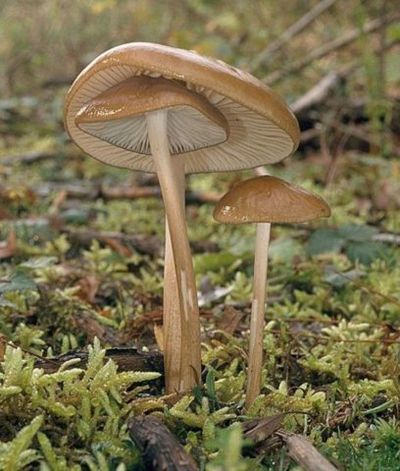
Description of the hat
Due to the long thin stem, the cap seems small, not paying attention to the fact that it can reach a diameter of 2-8 cm.In young specimens, it is hemispherical, straightens with age, becomes flat, while maintaining a small tubercle in the very center.
The wrinkled surface is covered in mucus and painted in olive, muddy lemon, or dark gray. The part below has even, sparse plates painted white or cream.
Leg description
Have Xerula root long thin stem, which can reach up to 20 cm in length and about 1 cm in thickness. It is buried in the soil by 15 cm, is often intertwined and has a non-standard rhizome.The fibrous pulp is covered with countless scales, which are painted pure white at the very base and gray-brown closer to the surface of the soil.
Eat a mushroom or not
Xerula root is an edible species that has health-improving qualities.
- The culture fluid contains the substance udenone, which is involved in the metabolic process, reduces blood pressure, and therefore the mushroom culture is advised to be taken by hypertensive patients. The species is very popular in China, and Chinese doctors use it in alternative medicine to treat hypertension.
- The pulp has antibacterial qualities, udemansin-X actively combats yeasts and molds.
- The mycelium contains polysaccharides that stop the growth of cancer cells.
Characteristics of use
Xerula's root pulp is light, watery, odorless and tasteless. The mushroom can be taken fried or pickled. Before cooking, the mushroom harvest is washed very thoroughly and boiled. To add flavor, spices and herbs are added to the dishes.
Where and how it grows
Xerula root prefers to grow in deciduous and coniferous forests. It can often be found on stumps, rotten wood, in semi-rotten wet dust. Mushrooms can grow singly and in groups, fruiting begins in mid-July and lasts until the end of September.
Doubles and their differences
Xerula root has 2 twins:
- Edible - Long-legged Xerula. This species has a thin long stem and a velvet grayish cap.
- dangerous - Scaly rogue. In terms of external properties, they are similar, but they have a difference - the lamellar layer of the false twin does not reach the leg.
Conclusion
Xerula root is an elegant, practical mushroom that grows in various regions of Russia. Due to its healing properties, Xerula root is widely used in alternative medicine. Regardless of the watery pulp and lack of taste, the mushroom is used for the preparation of many dishes.
Gray lamellar honey fungus (Hypholoma capnoides)
- Other names for the mushroom:
- False foil seroplate
- Poppy honey
- Poppy
- Gifoloma poppy
- Gifoloma ocher-orange
Synonyms:
Seroplate honey fungus (Latin Hypholoma capnoides) is an edible mushroom from the genus Hypholoma of the Strophariaceae family.
Cap of seroplate honeydew:
A diameter of 3-7 cm, from hemispherical in the youngest mushrooms to convex-outstretched at maturity, often with remnants of a private veil along the edges. The cap itself is hygrophane, its color strongly depends on humidity: in dry mushrooms it is dull yellow with a more saturated middle, in wet mushrooms it becomes brighter, light brown. As it dries, it begins to brighten symmetrically from the edges. The flesh of the cap is thin, whitish, with a faint odor of dampness.
Plates:
Frequent, adherent, white-yellowish in young fruit bodies, acquiring the characteristic color of poppy seeds as they grow older.
Spore powder:
Brown violet.
The peduncle of the gray-lamellar mushroom:
5-10 cm in height, 0.3 - 0.8 cm in thickness, cylindrical, often curved, with a rapidly disappearing ring, yellow in the upper part, rusty brown in the lower part.
Spreading:
Gray lamellar honey fungus is a typical tree fungus. Its fruiting bodies grow in bunches on stumps and roots hidden in the ground. It grows only in coniferous forests, most often on pine and spruce, both in the lowlands and high in the mountains. It is especially abundant in mountain spruce forests. The honey fungus is widespread throughout the temperate zone of the northern hemisphere. You can collect it from spring to autumn, and often in mild winters. It grows like a "honey agaric", in large intergrowths, meeting, perhaps, not so often, but quite abundantly.
Similar species:
Several common species of the genus Hypholoma, as well as, in some cases, summer honey fungus, are similar to the seroplate honeydew. It is, first of all, a poisonous pseudo-froth (hypholoma) sulfur-yellow with yellow-green plates, a cap with sulfur-yellow edges and a sulfur-yellow flesh. Next comes the pseudo-froth - brick-red hypholoma (H.sublateriiium) with yellow-brown plates and a brown-red cap, growing in bunches in summer and autumn in deciduous forests and outside the forest, especially on oak and beech stumps. Even without knowing the mushroom, it is only by formal signs that Hypholoma capnoides can be distinguished from the sulfur-yellow honey fungus (Hypholoma fasciculare): the one has green plates, and the gray-plastic one has poppy-gray. The rooted hypholoma (Hypholoma radicosum) mentioned in some sources, in my opinion, is completely different.
Edibility:
Seroplate honeydew has a reputation for being a good edible mushroom. In my opinion, it is very similar to the summer mushroom; old specimens take on a musty, raw taste.
Video about mushroom honey fungus:
Gray-lamellar millet - a good edible mushroom has a blue-gray, poppy-colored, lamellar, yellow-brown cap, whitish flesh and a pleasant taste.
The seroplate honeydew for me was and remains the "second summer honeydew". When we were introduced, they told me so - here they say you are another summer honey agaric, which grows on pine stumps. I believed, which, however, I still do not regret. And what?..
How to cook a mushroom?
Drying mushrooms are good in any form. They should be cooked immediately after they get home. The maximum shelf life fresh is possible up to 24 hours. The simplest thing is to fry mushrooms with onions and serve with boiled potatoes, but there are other interesting recipes.
Primary processing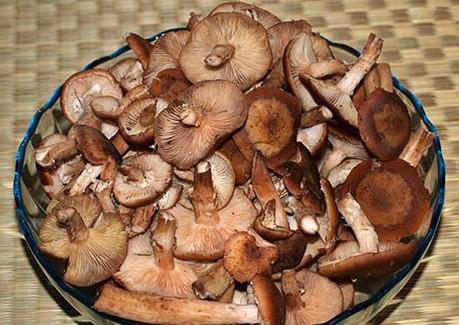
After the mushrooms have entered the house, they should be rinsed under running water and cleaned of forest debris. Remove all wormholes and rotten fruit, if any. Then immerse them in a bowl of water for an hour, where it will be easier for them to get rid of the debris that remains. Dry the mushrooms, now you can cook.
Pickling
For the preparation you will need:
- mushrooms - 1 kg;
- water - 350 ml;
- salt - 1 tbsp. l .;
- sugar - 1 tbsp. l .;
- vinegar - 2 tbsp. l .;
- sunflower oil - 50 ml;
- cloves - 2 pcs.;
- allspice - 3 pcs.;
- laurel leaves - 1pc.
To make mushrooms more tasty, before marinating, they should be boiled in water for 20 minutes, then the fruits are taken out, allowed to drain. Further preparation:
- Put a container of water on the fire, put salt, sugar, cloves, pepper and laurel. The marinade is boiled for 5 minutes.
- Pour in mushrooms, add vinegar after 15 minutes.
- After 10 minutes, the fruits are laid out in jars, a little vegetable oil is added on top, covered with a plastic lid and cooled at room temperature.
You can store such mushrooms in the basement or in the refrigerator on the bottom shelf. They are good not only as a separate dish, but also in salads, gravies and pies.
Salting
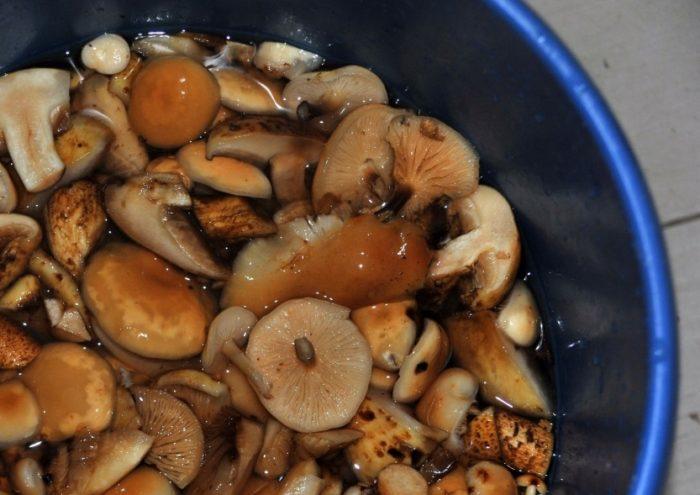 To crunch salty mushrooms, you will need:
To crunch salty mushrooms, you will need:
- mushrooms - 2 kg;
- salt - 100 g;
- dill - 6 umbrellas;
- onions - 120 g;
- vegetable oil - 100 ml.
After preliminary preparation, put honey mushrooms in a saucepan and put on fire:
- Bring to a boil, after 1 min. drain the water, rinse the fruit bodies and, pouring fresh water, put it back on the fire.
- Now they are boiled for half an hour.
- Then drain the water, put the mushrooms in an enamel container, sprinkle them with salt, add 100 ml of water, cover with a plate and put the load.
- Honey mushrooms are salted for up to 20 days in a cool place, preferably in the refrigerator.
When serving, season the mushrooms with vegetable oil, add finely chopped onions and dill to them.
Drying
Mushrooms can be dried by stringing them in the sun, as well as in the oven, on the stove or in an electric dryer. It is dry mushrooms that retain the largest amount of nutrients. Pre-cooking will be slightly different:
- After the mushrooms have got home, it is enough to clean them of debris, separate them from each other, and cut the large ones into pieces, so they dry faster.
- To dry in the sun, string them on a string and hang in a sunny warm place.
- When using the oven, you will need to warm up the device to 70 degrees, spread the mushrooms on a baking sheet and place inside. They will dry for more than 5 hours, and therefore you should constantly monitor the process, turn the fruits in time.
- The mushrooms will be ready in the electric dryer in 3.5 hours, the temperature should be set at 50 degrees.After this time, the fruits are not taken out, but left for another 3 hours, then you need to turn on the device at 60 degrees and dry it.
Well-dried mushrooms should be springy, not break, but completely dry. If they began to crumble, then drying takes too long, the mushrooms are overexposed.
Description of the mushroom
Shrinking mushroom, non-ringed or shrinking oak has the Latin name Armillaria tabescens, in addition, there are several more synonyms:
- Desarmillaria tabescens;
- Agaricus tabescens;
- Armillaria mellea;
- Clitocybe monadelpha;
- Collybia tabescens;
- Lentinus caespitosus;
- Pleurotus caespitosus;
- Monodelphus caespitosus;
- Pocillaria caespitosa.

It belongs to the genus of honey agarics of the physalacrium family. The cap grows up to 10 cm in diameter, convex in shape, then wide-convex and later flattened. A wide tubercle is located in the center, the surface is dry, the color is brown, slightly reddish. Covered with darker scales, which disappear as the fungus ages.
The hymenophore is lamellar. The lower part of the cap, adhering to the stem, may descend a little, has a white color, then acquires a pink tint. Spores are creamy.
The pulp is white, sometimes milky or yellowish, may be brown, has a strong odor, astringent taste, does not change color on the cut.
The leg is up to 12 cm high, and only 1.5 cm thick. In the lower part, it is narrowed, smooth, pinkish, whitish, less often brown in color, approaching the hat brightens. There is no ring, it is hollow inside.
The first mention of this mushroom is recorded in the book "Flora carniolica" by the Italian botanist Giovanni Scopoli. The description was made in 1772, the author of this mushroom referred to Agaricus tabescens. Later, in 1921, the mycologist Emel L. transferred it to the genus Armillaria.



